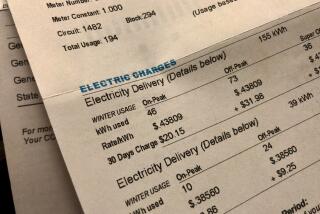Column: How much does a cable box really cost? The industry would prefer you don’t ask
Spectrum TV and internet customers will see their rates go up again in November.
Among other increases, the broadcast TV surcharge will rise to $9.95 from $8.85 a month, and the monthly fee for a set-top box will jump to $7.50 from $6.99.
It was that last charge that got my attention — and got me thinking about the economics involved.
How much do cable boxes actually cost? Why do their monthly fees keep going up when the cost of similar technology, such as TVs and computers, goes down over time?
Not surprisingly, my attempts to answer these questions were met with stonewalling from industry players.
Spectrum, owned by Charter Communications, the dominant pay-TV company in Southern California, clammed up real fast when I asked how much they pay for the boxes they lease to subscribers.
Nor would it comment on how much cash flow the boxes generate, or why fees keep rising even as the number of residential TV subscribers dwindles (down 66,000 more in the third quarter).
Dennis Johnson, a company spokesman, said only that the 7.3% higher box charge in November — more than three times the inflation rate — represents a “modest increase” that is “comparable or even lower than our major competitors.”
(Full disclosure: The Los Angeles Times is collaborating with Spectrum on a new L.A.-focused cable channel.)
I also went knocking at the door of Arris International, the world’s largest supplier of set-top boxes to pay-TV companies. I asked how much it costs the company on average to make a box.
My inquiries were met at first with a thunderous “no comment.”
“Arris will not participate in this story,” a company spokeswoman said.
A couple of days later, I received an email from Jeanne Russo, Arris’ senior director of global communications, who more pleasantly explained that “we don’t share specifics on margins, manufacturing origins or average/median prices paid by our customers publicly, so we won’t be able to help you with those questions.”
She also wanted me to understand that “set-tops are premium devices” and are becoming “the digital nerve center of the ultra-connected home.”
Alexa and Siri might have something to say about that. And the cost of smart speakers keeps falling.
I find it intriguing that something as ubiquitous as set-top boxes, found in nearly all American homes, is shrouded in such mystery. The implication is that consumers shouldn’t worry their pretty heads about how much the boxes really cost.
That’s usually a sign someone in the executive suite is having a good laugh at our expense.
I also wondered what happened to that push from the Federal Communications Commission to standardize set-top boxes and introduce much-needed competition into the marketplace.
That was easier to find out.
In case you’ve forgotten, former FCC Chairman Tom Wheeler noted in 2016 that the average pay-TV subscriber shelled out $231 a year to lease a set-top box from their service provider. The collective tab for that racket was $20 billion a year.
And you had to keep paying, even after the pay-TV company recouped its bulk-rate investment in the gear.
Wheeler’s solution was to establish uniform technical standards so any electronics manufacturer could make one-size-fits-all cable boxes. Pay-TV companies in turn would make free apps available to subscribers so they could access programming on any device.
“If you want to watch Comcast’s content through your Apple TV or Roku, you can,” Wheeler wrote in an op-ed in these pages. “If you want to watch DirectTV’s offerings through your Xbox, you can. If you want to pipe Verizon’s service directly to your smart TV, you can.”
He added: “These rules will open the door for innovation, spurring new apps and devices, giving consumers even more choice and user control.”
Once President Trump installed his own guy as FCC chairman, however, a more industry-oriented mind-set took hold. Wheeler’s plan was promptly tossed in the trash.
Ajit Pai, the agency’s new boss, said Wheeler’s proposal “is no longer pending before the commission, and I do not intend to resurrect it.”
He never really explained why, except to say he didn’t think standardized boxes promoted “a clear, consumer-focused, fair and competitive regulatory path for video programming delivery,” which is, of course, nonsense.
Several years ago, Sen. Edward J. Markey (D-Mass.) and Sen. Richard Blumenthal (D-Conn.) asked all the leading pay-TV service providers to shed a little light on set-top boxes. Like me, they were keen to find out how much a box really costs.
Like me, they got nowhere.
Charter said the average amount customers spend in monthly box fees “is confidential.” Likewise, revenue generated for the company by such fees “is confidential information.”
DirecTV said that “much of the information you have requested is proprietary, business sensitive and highly confidential.”
Cox Communications said it “does not disclose the confidential, proprietary and competitively sensitive information requested.”
“This information is not publicly available because of competitive sensitivity,” Comcast said.
I phoned around to Wall Street analysts who cover Arris. They couldn’t say how much it costs the company to manufacture set-top boxes in low-cost factories abroad.
But the general consensus was that Arris sells basic boxes to pay-TV companies for about $150 apiece and more advanced boxes for closer to $250.
If the FCC was right about the average customer paying $231 a year (as of 2016), that suggests the typical pay-TV company is recouping its investment per box in about a year or less, and all fees paid beyond that point are pure gravy, even allowing for any maintenance expenses.
Each analyst I spoke with said box fees aren’t a huge source of revenue for pay-TV companies, but they obviously add up.
Charter, for example, still has more than 16-million residential customers with set-top boxes, many with multiple boxes.
After the Spectrum fee rises within days to $7.50 a month, that will translate to at least $120 million. Monthly. Or at least $1.4 billion a year.
Rival Comcast charges $9.95 monthly for a high-definition box. It has about 22-million TV subscribers. It’s thus looking at potential revenue of $2.6 billion annually.
Yeah, if I ran a pay-TV company, I’d want to keep that to myself as well.
David Lazarus’ column runs Tuesdays and Fridays. He also can be seen daily on KTLA-TV Channel 5 and followed on Twitter @Davidlaz. Send your tips or feedback to david.lazarus@latimes.com.
More to Read
Inside the business of entertainment
The Wide Shot brings you news, analysis and insights on everything from streaming wars to production — and what it all means for the future.
You may occasionally receive promotional content from the Los Angeles Times.











